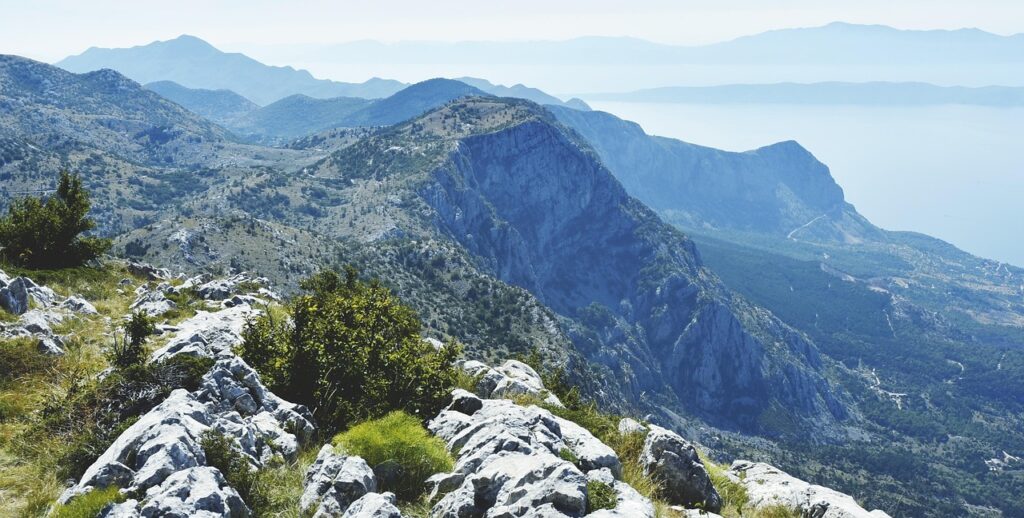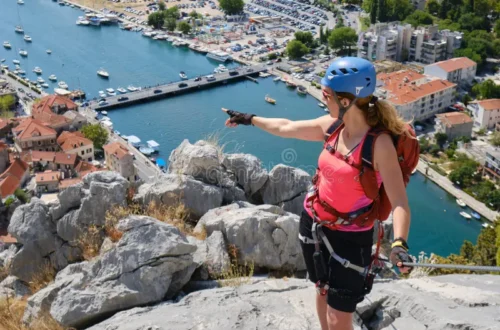Via Ferrata Vaganacki Kuk: An exciting Gem in Paklenica’s Limestone Majesty
Croatia’s Paklenica National Park is known among climbers and hikers for its sheer limestone cliffs, lush canyons, and stunning views over the Dalmatian coast. It is also home to the Via Ferrata Vaganacki Kuk. Many adventurers are familiar with its famous sport climbing routes and deep canyons like Velika and Mala Paklenica. The thrilling via ferrata that ascends the dramatic peak of Vaganacki Kuk isn’t as well known but it is one of the more advanced and awe-inspiring fixed-cable climbs in the region.
Tucked away on the high cliffs above the Adriatic, Via Ferrata Vaganacki Kuk offers a great blend of adrenaline, solitude, and breathtaking views. For those looking to combine vertical adventure with the natural beauty of Croatia’s rugged interior, this route promises an unforgettable experience.

Where Is Vaganacki Kuk?
Vaganacki Kuk is part of the Velebit mountain range, the longest in Croatia, which stretches parallel to the Adriatic Sea. This specific via ferrata route is in Paklenica National Park, a protected area known for its diverse geology, deep canyons, and vast limestone formations.
The park’s lower elevations are popular and often bustling — particularly the Velika Paklenica gorge with its famous climbing crags — but Vaganacki Kuk sits higher and away from the main paths. This makes the via ferrata not only more demanding but also more secluded, appealing to those seeking a quieter and more rugged experience.
Click here for another fantastic Via Ferrata in Croatia.
An Overview of the Route
- Grade: Difficult (C to D in via ferrata grading)
- Length: Approx. 1.5–2 km including access
- Elevation Gain: 300–400 meters
- Duration: 3–5 hours total (including approach and descent)
- Access Point: From the village of Mali Alan or the Vaganac saddle
- Best Season: Late spring to early autumn (May–October)
The route follows a steep and exposed line up the flanks of Vaganacki Kuk, a prominent limestone summit at around 1,175 meters. With vertical rock faces, narrow ledges, and technical climbing sections, it is not recommended for beginners. Climbers should be in good physical shape, have solid footing, and be comfortable with heights and exposure.
Click here for a great selection of adventures in Europe.
The Climb: What to Expect
1. The Approach
Reaching the start of the via ferrata involves a moderate hike along marked mountain trails. From the Mali Alan pass, a gravel road and trail lead toward the base of the Vaganacki Kuk formation. The area is remote and offers a dramatic transition from forested slopes to exposed rock.
Early on, the trail winds through a mix of beech and pine forest, gradually thinning as you climb higher into alpine terrain. Depending on the season, the area may be ablaze with wildflowers, or echoing with the calls of birds of prey that nest in the cliffs above.

2. The Via Ferrata Begins
The ferrata starts at a vertical slab where the first steel cables and iron rungs come into view. You’ll quickly realize that this is not an easy climb. The initial pitches are steep, with some short overhanging sections that demand good upper body strength and confidence in your climbing gear.
The route is fully protected, with modern safety cables and anchor points, but it still needs technique and mental focus. Unlike some tourist-oriented via ferratas, Vaganacki Kuk was designed for seasoned adventurers who want a genuine challenge.
3. Exposed Traverses and Vertical Climbs
After the initial ascent, the route goes along exposed ridges and traverses, offering stunning views of the surrounding peaks and even glimpses of the sea on a clear day. There are moments when you’ll be moving sideways across sheer rock faces, with nothing but the cable and your harness for comfort. The drop below is dramatic, but the quality of protection and the solidity of the rock provide reassurance.
The climb includes several vertical sections that require precise footwork and thoughtful movement. Here, gloves are essential to protect your hands from the steel cable and sharp limestone.
Click here for some stylish, practical and outdoors appropriate menswear.
4. The Summit and the Panorama
The final push to the summit includes a few more strenuous pitches, but the reward is immense. Upon reaching the top of Vaganacki Kuk, you’re greeted with a 360-degree panorama that is nothing short of breathtaking. To the south, the jagged peaks of Paklenica and the sea shimmer in the distance. To the north and east lie the rugged ridgelines of the Velebit massif.
It’s a perfect place to rest, refuel, and soak in the silence. Here, far from the tourist routes, it’s just you, the wind, and the mountains.
If you want to lose weight before your trip click here.
5. The Descent
The descent follows a marked hiking path, which loops around the back of the mountain and returns you to your starting point. While there are no technical sections on the descent, the trail is steep and loose in places, so careful footing is essential.
Who Should Do This Route?
Via Ferrata Vaganacki Kuk is ideal for:
- Experienced via ferrata climbers
- Adventure travelers looking for a remote and wild experience
- Those with good fitness and no fear of heights
- Climbers who want to avoid tourist crowds and explore deeper into Paklenica’s backcountry
It’s not suitable for beginners or children, and it’s highly recommended to go with a guide if you’re unfamiliar with the area.
Click here to learn about an incredible European adventure holiday spanning four countries.
Essential Gear
- Certified via ferrata set (harness, lanyards with energy absorber, helmet)
- Gloves for cable grip
- Sturdy hiking or approach shoes with good traction
- Water and snacks – no sources along the way
- Weather-appropriate clothing – conditions can change rapidly
- Map or GPS – some parts are remote and poorly marked
Combining Vaganacki Kuk With Other Adventures
If you’re in the Paklenica region, this route can be part of a broader adventure itinerary that includes:
- Sport climbing in Velika Paklenica canyon
- Hiking to Sveto Brdo or Vaganski Vrh, Velebit’s highest peak
- Caving or canyoning in nearby Zrmanja and Krupa canyons
- Relaxing on the beaches near Starigrad-Paklenica after a day in the mountains
Conclusion: Croatia’s Wild Side
While Croatia is famous for its turquoise coastline and medieval towns, the Via Ferrata Vaganacki Kuk reminds us that some of the country’s most exhilarating experiences lie inland, in its rugged mountains and wild landscapes. This ferrata offers not just a physical challenge, but a true alpine adventure — where you’ll push your limits, find peace in solitude, and gain a fresh appreciation for Croatia’s untamed beauty.
If you’re seeking a via ferrata that delivers both vertical excitement and deep immersion in nature, Vaganacki Kuk should be at the top of your list.

